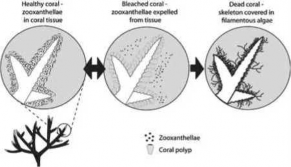4.8.6. Coral Bleaching
♤ Bleaching, or the paling of coral colour occurs when ( i) the densities of zooxanthellae decline and / or
( ii) the concentration of photosynthetic pigments within the zooxanthellae fall.

Coral Bleaching
♤ When corals bleach they commonly lose 60-90% of their zooxanthellae and each zooxanthella may lose 5080% of its photosynthetic pigments.
♤ If the stress-causing bleaching is not too severe and if it decreases in time, the affected corals usually regain their symbiotic algae within several weeks or a few months.
♤ If zooxanthellae loss is prolonged, i.e. if the stress continues and depleted zooxanthellae populations do not recover, the coral host eventually dies.
♤ High temperature and irradiance stressors have been implicated in the disruption of enzyme systems in zooxanthellae that offer protection against oxygen toxicity.
♤ Photosynthesis pathways in zooxanthallae are impaired at temperatures above 30 degrees C, this effect could activate the disassociation of coral / algal symbiosis.
♤ Low- or high-temperature shocks results in zooxanthellae low as a result of cell adhesion dysfunction.
♤ This involves the detachment of cnidarian endodermal cells with their zooxanthellae and the eventual
expulsion of both cell types.
